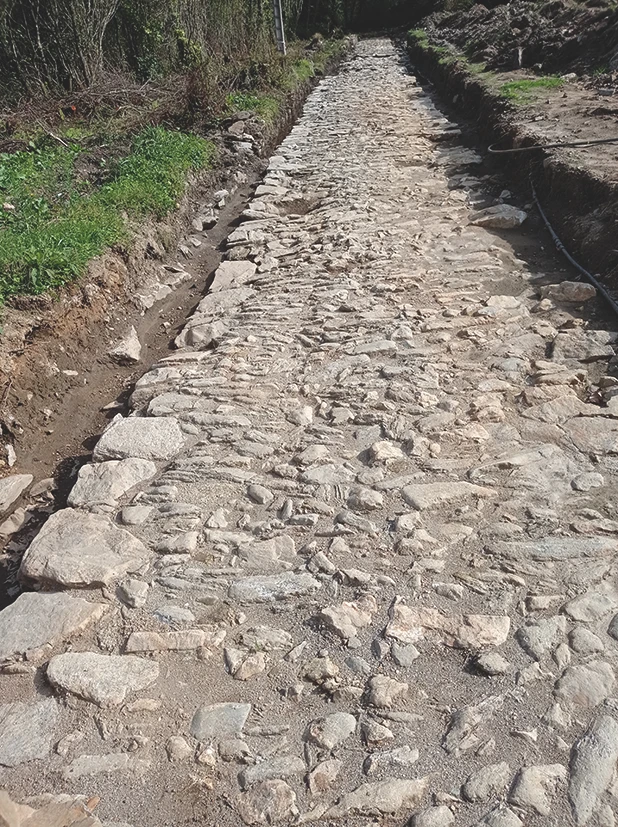The Romans’ first contact with the westernmost region of the Iberian Peninsula took place in 139 BCE, during the first expedition led by Quintus Servilius Caepio, the time when the first reference is made to callaicoi. Two years later, an expedition led by the consul Decimus Junius Brutus set out with the intention of conquering the ancient Lusitania. His army was the first to cross the river Letheo (Lima), the so-called river of forgetfulness. These incursions did not lead to the subjection of the tribes settled in the western part of the region. Contemporary writers say that Brutus and his army were terrified when they reached the coast and saw huge waves and a spectacular sunset. After the expedition, Brutus was given the honorary nickname of “Callaicus”.
A naval expedition led by Julius Caesar arrived at the port of Brigantium (A Coruña) in 60 BCE. His plan was to conquer the rebellious tribes and seize their wealth. He returned to Rome without having achieved his goal. In 26 BCE, Augustus arrived in the region at the head of several legions to put an end to the rebellious tribes and subject them to the laws and authority of Rome. Once the territory was pacified, the Aras Sestianas (altars) were built in honour of Augustus in 16 BCE; their exact location is unknown.
The territory was later organised once again, and the indigenous peoples were obliged to abandon their hillforts and settle in the flatter areas. From then on, the territory of Gallaecia was divided into three jurisdictional regions: Bracara, Astúrica and Lucus, where all political and military power was centralised. The area of Costa da Morte was included in the latter.
To control the territory and exploit the mines, the primary goal of the Romans in the north west of the Peninsula, three roads were built to link the capitals of the three administrative regions: via XVIII, via XIX and via XX. The third was also called “per loca marítima”, as it passed close to the sea. It is believed to have crosses part of Costa da Morte, but no agreement has been reached by historians about its route. There is growing evidence to confirm that the mansio or official stopping point of Glandimiro coincides with the present-day municipality of Brandomil (Zas). Many Roman remains have been found in this region: three votive altars, a funerary pediment, a funerary panel, remains of columns and a lot of Roman pottery. The excavations promoted by the Fundación Brandomil, sponsored by the municipality of Zas and directed by the archaeologist Lino Gorgoso, have made some important new discoveries, such as the remains of a Roman road and a structure that may be a mansio, which may be linked to the ancient road. From here it would cross the region of Xallas, enter Bergantiños via the lagoon of Alcaián and cross the river Rosende, where the Lubián bridge is now located. Carballo may have been home to another mansio where ancient baths and traces of thermal springs were found. It then headed off towards Vilaño (A Laracha), where a milestone was found, then Arteixo, before finally reaching the city of Brigantium.

Besides the Roman settlement at Brandomil, most likely established because of the gold mine of Pozo Limideiro, Roman remains have been found in many other parts of this coastal region. Excavations conducted at Duio (Fisterra) in the 1940s by a local doctor, Francisco Esmorís Recamán, brought to light prehistoric tools and Roman roof tiles. Local legends also link the area to the presence of the Romans.
Traces of what may have been a Roman villa were found in Moraime in 1972, to the south of the modern parish church of San Xulián. The finds include the remains of a hypocaust, fibulae, beads, coins and many fragments of pottery, linked to the late Roman period. A similar discovery was made in Tines (Vimianzo), where the archaeologist Manuel Chamoso Lamas discovered a Roman-Suebian necropolis in 1951, with stone and tile- built sarcophagi, and traces of a Roman mansio. The funerary stele of Victorinus was found in the same place, and is now on display in the Archaeological and Historical Museum at the Castle of Santo Antón in A Coruña. It is the oldest written evidence of the presence of Christianity in Galicia.

Possible remains of Roman villas were also found in Agra da Cruz (Gándara, Zas), Cores (Ponteceso), where two Roman altars and other finds from the same period can be seen in the parish church. Remains of a Roman necropolis was also discovered near the church of Cances (Carballo), where several tombs made with tiles were found. Roman pottery has been found in many other places.
Romanarmy, the international research group, and researchers from the University of Santiago de Compostela, discovered a group of provisional Roman encampments that have contributed to increasing knowledge about the conquest of Gallaecia. Five of these encampments were found in the province of A Coruña, one of which was discovered next to the castro of Santa Baia (Soandres, A Laracha).